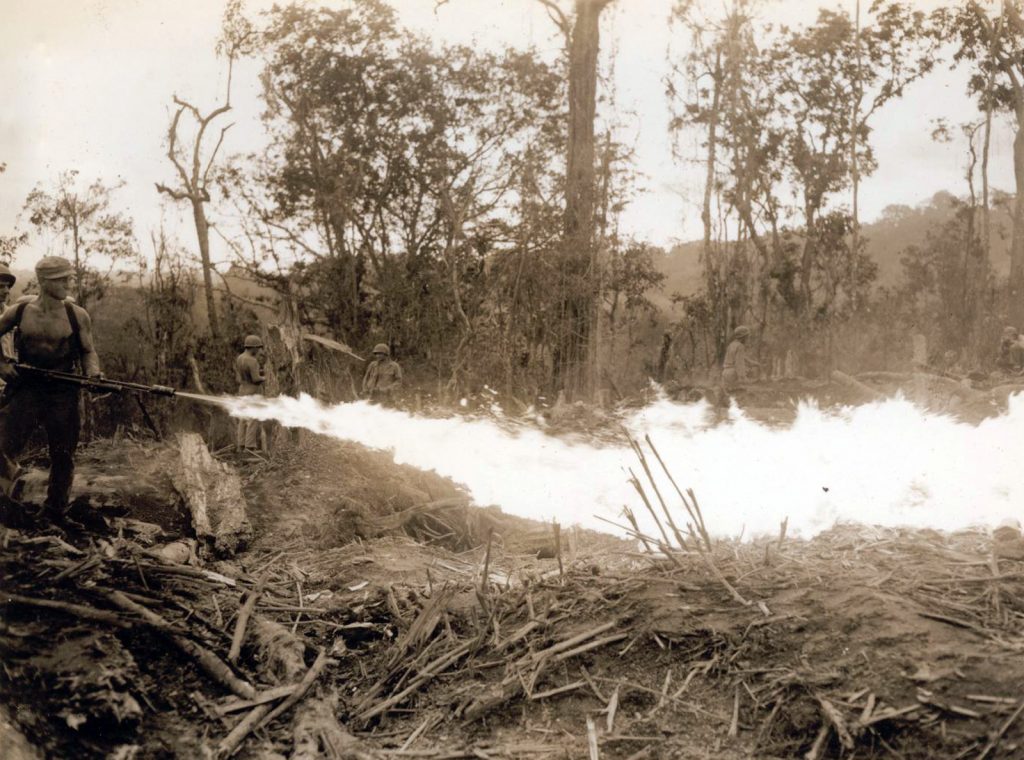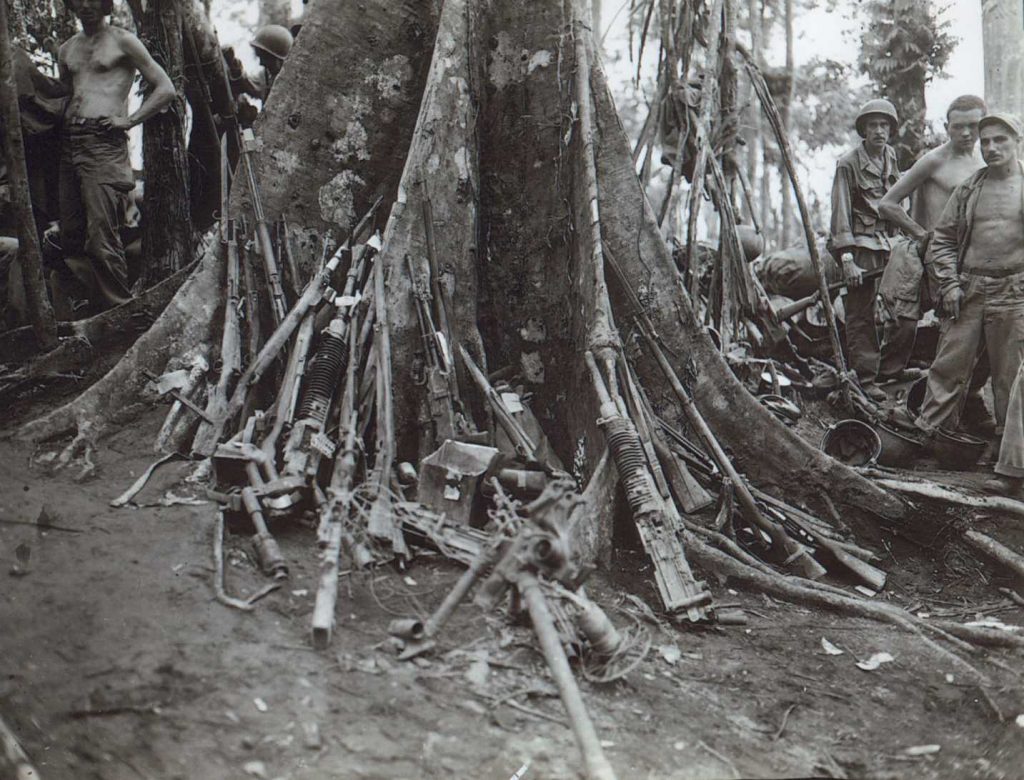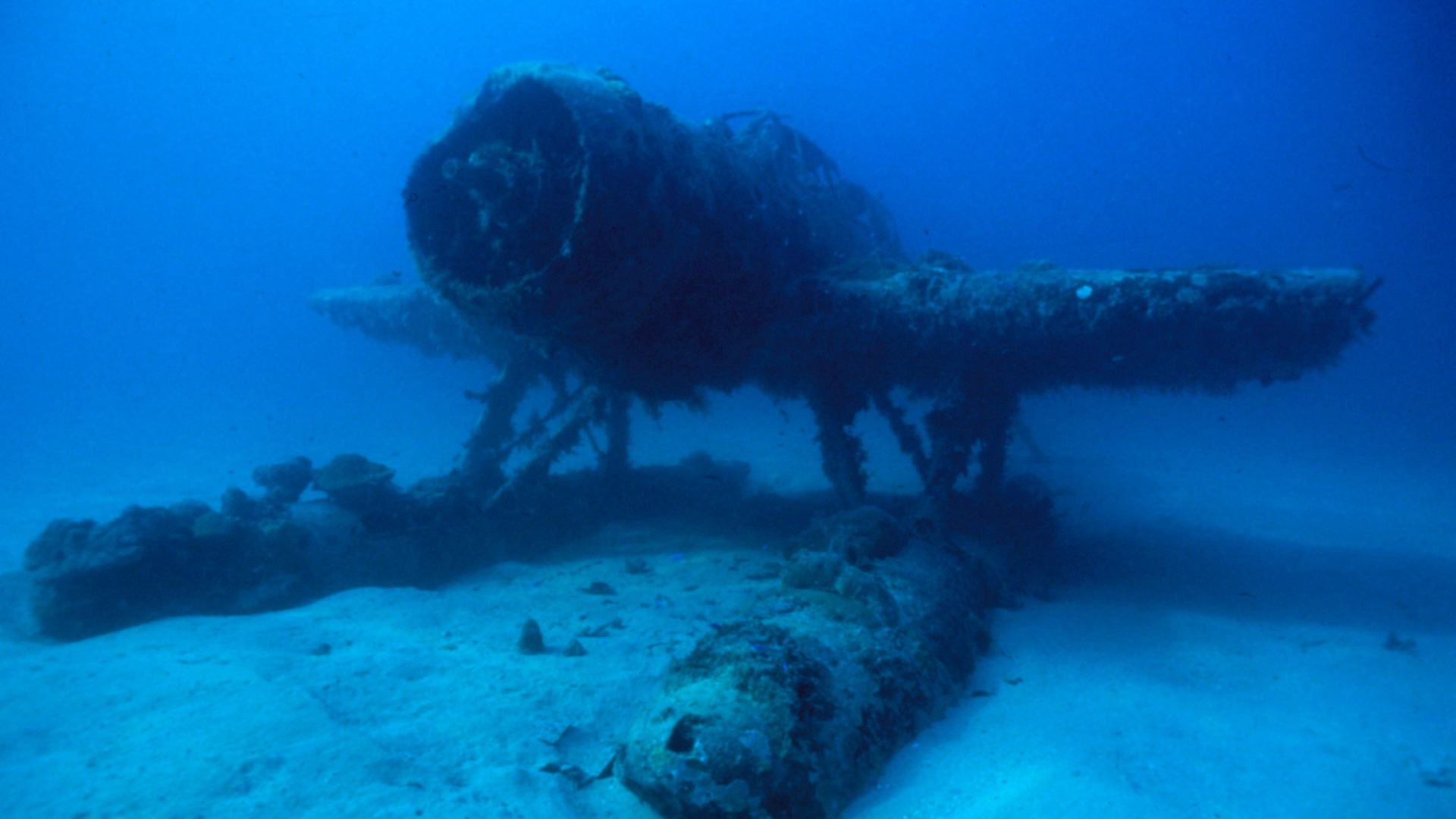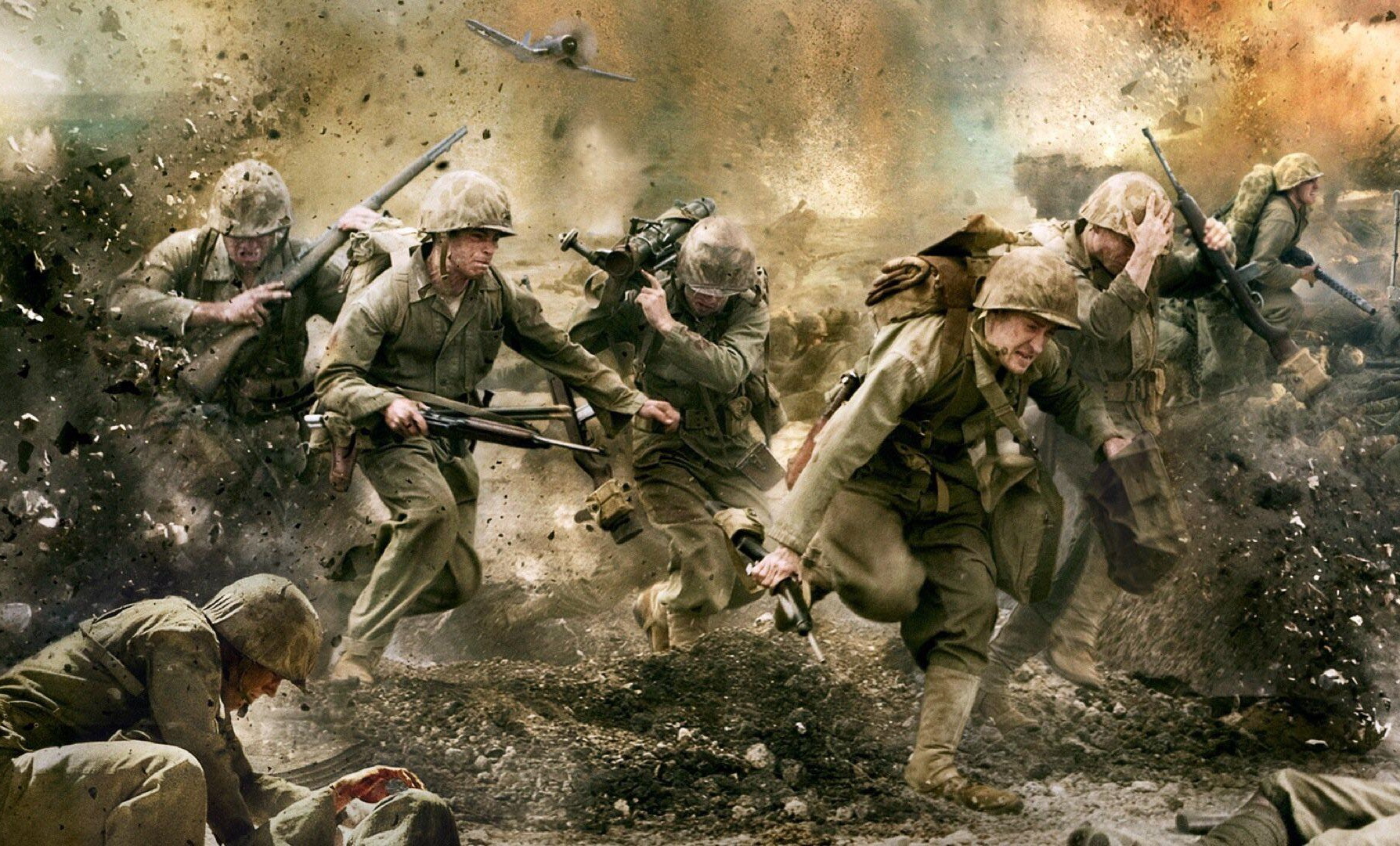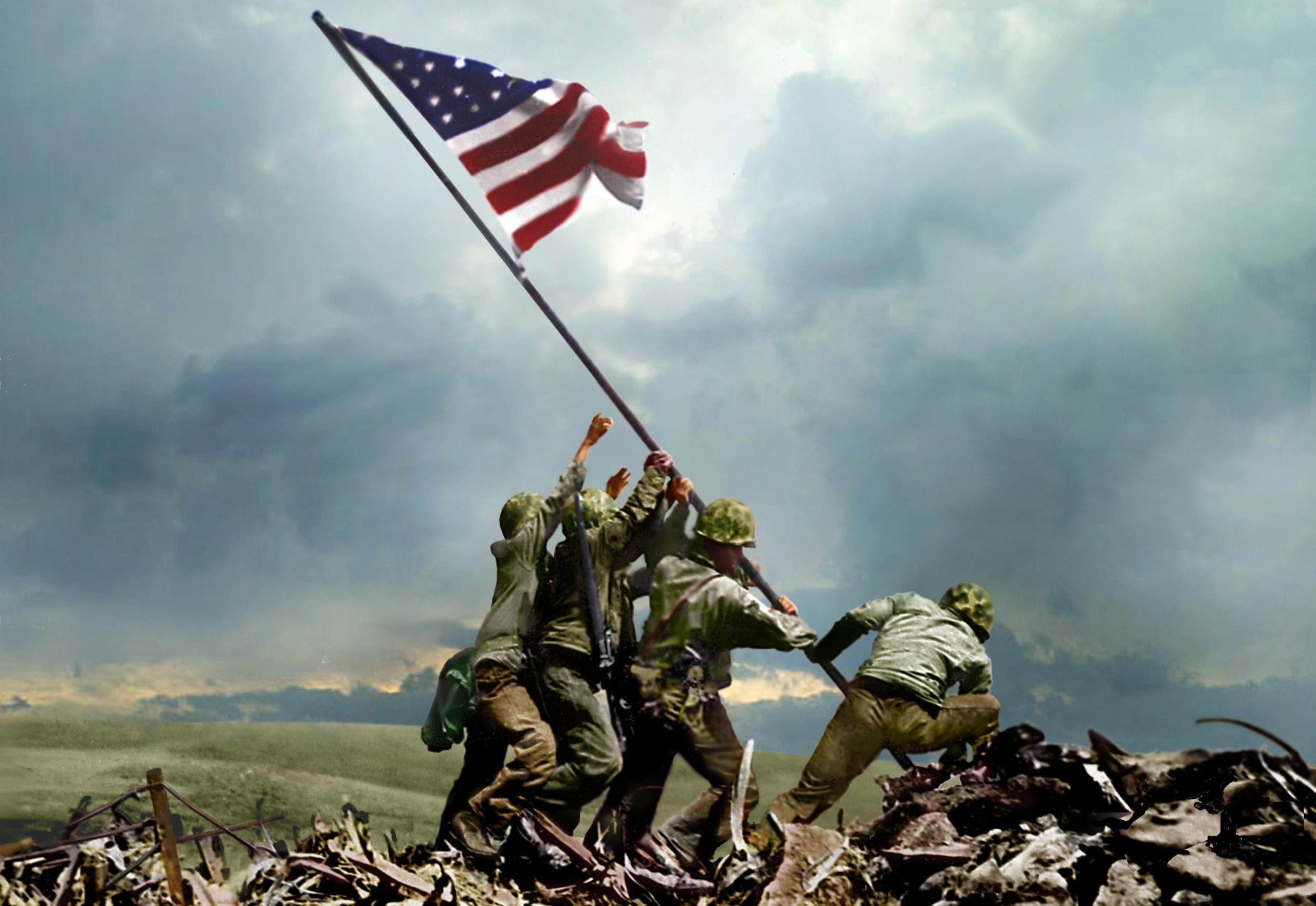 That was not the only action for the paratroopers on December 9. That morning the provisional battalion had sent a platoon of Item Co reinforced by two weapons company machine gun squads on a patrol to circle the eastern spur and investigate the area between it and the Torokina River. The unit moved out to the northeast and reached the rear of Hellzapoppin Ridge, where it came upon two Japanese setting up a machine gun along the trail. The Marine point man observed the activity and alerted the patrol leader, Capt Jack Shedaker, who killed both in quick succession with his carbine. Unknown to the Marines, they were in the midst of a Japanese ambush and the enemy immediately returned fire from positions in a swamp on the left side of the trail.
That was not the only action for the paratroopers on December 9. That morning the provisional battalion had sent a platoon of Item Co reinforced by two weapons company machine gun squads on a patrol to circle the eastern spur and investigate the area between it and the Torokina River. The unit moved out to the northeast and reached the rear of Hellzapoppin Ridge, where it came upon two Japanese setting up a machine gun along the trail. The Marine point man observed the activity and alerted the patrol leader, Capt Jack Shedaker, who killed both in quick succession with his carbine. Unknown to the Marines, they were in the midst of a Japanese ambush and the enemy immediately returned fire from positions in a swamp on the left side of the trail.
 The first burst of fire killed one Marine, but the parachute machine gunners quickly got their weapons in action and opened a heavy return fire into the swamp. While the tail-end Marine squad tried to flank the enemy position, other paratroopers moved up onto the higher ground on the right side of the trail to obtain better fields of observation and fire. The Japanese soon withdrew under this withering response, but not without heavy losses since they had to cross open ground in full view of Marines on the slope above them. The patrol estimated that it killed 16 Japanese, though the regiment later downgraded the claim to 12. The reinforced platoon retraced its steps to the Marine perimeter, its only loss being the one man killed at the start of the ambush. At least one other patrol made contact that day and one of its machine gun squads became separated in the fight. A third patrol sent to search for the missing men came up empty-handed. Three of the machine gunners made it back to friendly lines the next day, but a lieutenant and three enlisted men remained missing.
The first burst of fire killed one Marine, but the parachute machine gunners quickly got their weapons in action and opened a heavy return fire into the swamp. While the tail-end Marine squad tried to flank the enemy position, other paratroopers moved up onto the higher ground on the right side of the trail to obtain better fields of observation and fire. The Japanese soon withdrew under this withering response, but not without heavy losses since they had to cross open ground in full view of Marines on the slope above them. The patrol estimated that it killed 16 Japanese, though the regiment later downgraded the claim to 12. The reinforced platoon retraced its steps to the Marine perimeter, its only loss being the one man killed at the start of the ambush. At least one other patrol made contact that day and one of its machine gun squads became separated in the fight. A third patrol sent to search for the missing men came up empty-handed. Three of the machine gunners made it back to friendly lines the next day, but a lieutenant and three enlisted men remained missing.
 The enemy continued to harass the paratroopers with small arms fire on the morning of December 10 and drove back a patrol sent out to recover Marine dead on Hellzapoppin Ridge. To deal with the problem, King and Love Cos withdrew 200 yards and called down a 45-minute artillery barrage. When they advanced to reoccupy their positions, they had to fight through Japanese soldiers who had moved closer to the Marine lines to avoid the artillery.
The enemy continued to harass the paratroopers with small arms fire on the morning of December 10 and drove back a patrol sent out to recover Marine dead on Hellzapoppin Ridge. To deal with the problem, King and Love Cos withdrew 200 yards and called down a 45-minute artillery barrage. When they advanced to reoccupy their positions, they had to fight through Japanese soldiers who had moved closer to the Marine lines to avoid the artillery.

 Later in the day, the 1st Battalion, 9th Marines, relieved the left of the parachute line and the 1st Battalion, 21st Marines, took over the right. Col Williams dissolved the provisional battalion and the rump regiment remained attached to the 9th Marines as its reserve force. Over the next few days, the paratroopers ran patrols and began building their portion of the corps’ reserve line of defense. The reserve mission was not entirely quiet, as the paratroopers suffered three casualties in a patrol contact and an air raid. Two machine gunners from the weapons company took matters into their own hands and went forward to the front lines searching for their comrades missing since December 9. Their unofficial heroics proved fruitless. Meanwhile, the 21st Marines spent the period of December 12/18 reducing Hellzapoppin Ridge. Their efforts were successful only after the corps supported them with a lavish outlay of aerial firepower (several hundred 100-pound bombs) and the dedicated assistance of a specially sited 155-MM artillery battery.
Later in the day, the 1st Battalion, 9th Marines, relieved the left of the parachute line and the 1st Battalion, 21st Marines, took over the right. Col Williams dissolved the provisional battalion and the rump regiment remained attached to the 9th Marines as its reserve force. Over the next few days, the paratroopers ran patrols and began building their portion of the corps’ reserve line of defense. The reserve mission was not entirely quiet, as the paratroopers suffered three casualties in a patrol contact and an air raid. Two machine gunners from the weapons company took matters into their own hands and went forward to the front lines searching for their comrades missing since December 9. Their unofficial heroics proved fruitless. Meanwhile, the 21st Marines spent the period of December 12/18 reducing Hellzapoppin Ridge. Their efforts were successful only after the corps supported them with a lavish outlay of aerial firepower (several hundred 100-pound bombs) and the dedicated assistance of a specially sited 155-MM artillery battery.

 The Army’s XIV Corps headquarters relieved 1-MAC in command of the operation on December 15 and the Americal Division began replacing the 3rd Marine Division on December 21. As part of this shift of forces, the regimental companies and 1st Battalion of the parachutists fell under Col Alan Shapley’s 2nd Raider Regiment, with Col Williams assuming the billet of executive officer of the combined force. While the 3rd Parachute Battalion continued as the reserve force for the 9th Marines, the raider and parachute regiment took over the front-line positions of the 3rd Marines on December 22. This placed them with their right flank on the sea at the eastern end of the Empress Augusta Bay perimeter. Army units relieved the 9th Marines on Christmas Day and the 3rd Parachute Battalion departed Bougainville soon thereafter. The 1st Battalion conducted aggressive patrols and made its only serious contact on December 28. Able Co crossed the Torokina River inland and swept down the far bank to the sea. Near the river mouth, it encountered a strong Japanese position and quickly reduced 8 pillboxes, killed 18 of the enemy, and drove off another 20 defenders. Three paratroopers died and two were wounded. Shapley joined the company to observe the final action and commended it for an ‘excellent job’. The 1st parachutists left Bougainville in the middle of January 1944 and sailed to Guadalcanal.
The Army’s XIV Corps headquarters relieved 1-MAC in command of the operation on December 15 and the Americal Division began replacing the 3rd Marine Division on December 21. As part of this shift of forces, the regimental companies and 1st Battalion of the parachutists fell under Col Alan Shapley’s 2nd Raider Regiment, with Col Williams assuming the billet of executive officer of the combined force. While the 3rd Parachute Battalion continued as the reserve force for the 9th Marines, the raider and parachute regiment took over the front-line positions of the 3rd Marines on December 22. This placed them with their right flank on the sea at the eastern end of the Empress Augusta Bay perimeter. Army units relieved the 9th Marines on Christmas Day and the 3rd Parachute Battalion departed Bougainville soon thereafter. The 1st Battalion conducted aggressive patrols and made its only serious contact on December 28. Able Co crossed the Torokina River inland and swept down the far bank to the sea. Near the river mouth, it encountered a strong Japanese position and quickly reduced 8 pillboxes, killed 18 of the enemy, and drove off another 20 defenders. Three paratroopers died and two were wounded. Shapley joined the company to observe the final action and commended it for an ‘excellent job’. The 1st parachutists left Bougainville in the middle of January 1944 and sailed to Guadalcanal.
The Closing Shock
The final reevaluation of the parachute program began in August 1943. In a one-page memorandum, the Division of Plans and Policies summarized the heart of the problem. Simply put, there were far too few transport planes in the entire Marine Corps for the regiment to jump into combat, which was its only reason for existence. The Marine Corps either needed to acquire many more aircraft or borrow squadrons from another service. Left unstated was a third option to get out of the paratroop business. That already was nearly a foregone conclusion, since Gen Vandegrift was the Commandant-designate and he had pronounced views about the future of special units in the Corps. Holcomb set things in motion with a formal recommendation on December 21 to disband both the parachute and the raider organizations. However, he did so with the strong concurrence of Vandegrift, who actually presented the proposal in person to Adm Ernest J. King, the Chief of Naval Operations.
Col Omar T. Pfeiffer, the Marine planning officer on King’s staff, summarized the position of Holcomb and Vandegrift. Deletion of the parachute program would save $ 150,000 per month in jump pay, free 3000 personnel for assignment to one of the new divisions, allow for uniformity of equipment and training within all Marine infantry units, and ‘avoid setting up some organizations as elite or selected troops’. King agreed to the plan on December 25. Except for a small cadre to provide an air delivery section for each of the two Marine Corps level headquarters in the Pacific, the 1st Parachute Regiment would return to the States and disband upon its arrival. Its manpower would form the core of the new 5th Marine Division. The 4th Battalion would disband at Pendleton and provide men for the general replacement pool.
Headquarters issued the official orders for this process on December 30. Vandegrift took the oath of office as the 18th Commandant of the Marine Corps on January 1 and one of his early official acts was ordering the closing of the Parachute Training School at Camp Gillespie. That personnel joined the 4th Battalion men in the replacement pool. The 2nd Parachute Battalion sailed from Vella Lavella on January 2 to join the rest of the regiment on Guadalcanal. The 1st and 2nd Battalions embarked for the States on January 18 and arrived in San Diego on February 4. The regimental headquarters and the 3rd Battalion departed Guadalcanal on January 30. The 1st Parachute Regiment officially furled its colors on February 29, 1944. The 5th Marine Division, leavened by the veterans of the 1st Parachute Regiment, would land at Iwo Jima barely a year later and distinguish itself in that bitter fight. Three parachutists would participate in the famed flag raising on Mount Suribachi on February 23, 1945.
Sgt Henry 0. Hansen helped put the first flag in place, Cpl Ira H. Hayes and Cpl Harlon H. Block were among the group of six featured in the Joe Rosenthal photograph of the second flag-raising. Of the 81 Marines to earn the Medal of Honor in World War II, five were former paratroopers who performed their feats of heroism on Iwo Jima. Several Marine parachutists did put their special training to use in combat. A handful of graduates of the parachute program joined the Office of Strategic Services (OSS) and jumped into occupied France in support of the resistance movement. Two officers participated as observers in an Army airborne assault in New Guinea. The Marine parachute units of World War II never jumped into combat, but they did make an indelible impression on the history of the Corps.



